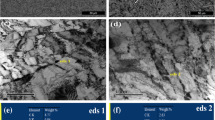Abstract
The BI (Ball Indentation) method has the potential to assess the mechanical properties and to replace conventional fracture tests. In this study, the effect of aging on mechanical behavior of lCr-lMo-0.25V steels procured by isothermal aging heat-treatment at four different aging times in the range of 0–1820 hours at 630h°C., were investigated using BI system.
Similar content being viewed by others
Abbreviations
- σ t :
-
True stress
- ε p :
-
True plastic strain
- K :
-
Strength coefficient
- D :
-
Diameter of ball indenter
- d p :
-
Plastic indentation diameter
- d t :
-
Total indentation diameter
- E i :
-
Elastic modulus of indenter
- E 2 :
-
Elastic modulus of specimen
- h t :
-
Total depth of indentation
- K ic :
-
Fracture toughness
- K q :
-
Fracture toughness (not satisfying the size requirements)
- Pmax :
-
Maximum indentation load
- S :
-
Inclination of indentation load-depth curve
- Q :
-
Activation energy
- R :
-
Gas constant
References
Abdel-Latif, A. M., Corbett, S. M. and Taplin, D. M. R., 1982, Metal Science, Vol. 16, pp. 90–96.
Haggag, F. M. and Murty, K. L., 1997, in: P. K. Liaw, O. Buck, R. J. Arsenault, R. E. Green Jr. (Eds.),Non-destructive Evaluation and Materials Properties III,TMS, Warrendale, PA, p. 101.
Haggag, F. M. and Nanstad, R. K., 1989, “Estimating Fracture Toughness using Tension or Ball Indentation Tests and a Modified Critical Strain Model,”The American Society of Mechanical Engineers PVP, Vol. 170, pp. 41–46.
Haggag, F. M., et al., 1990, “Use of Automated Ball Indentation Testing to Measure Flow Properties and Estimate Fracture Toughness in Metallic Materials,”ASTM STP 1092, pp. 188– 208.
Haggag, F. M., 1993, “In-Situ Measurements of Mechanical Properties Using Novel Automated Ball Indentation Systems,” Small Specimen Test Techniques Applied to Nuclear Reactor Vessel Thermal Annealing and Plant Life Extension,ASTM STP 1204, pp. 27–44.
Mathew, M. D. and Murty, K. L., 1999, “Nondestructive Studies on Tensile and Fracture Properties of Molybdenum at Low Temperatures,”Journal of Materials Science, Vol. 33, pp. 1497- 1503.
Nham, S. H. and Kim, A. K., 1998, “Nondestructive Evaluation of Toughness Degradation of lCr-lMo-0.25V Steel Using Electrical Resistivity,”Transaction of KSME A, Vol. 22, No. 5, pp. 814–820.
Seok, C. S, Kim, D. J. and Bae, B. K., 2000, “Evaluation of Material Degradation Using Electrical Resistivity Method,”Transaction of KSME A, Vol. 24, No. 12, pp. 2992–3002.
Tabor, D., 1951,The Hardness of Metals, Oxford University Press, New York.
Yamashita, M., et al., 1997, “Service-induced Changes in the Microstructure and Mechanical Properties of a Cr-Mo-Ni-V Turbine Steel,”ISIJ International, Vol.37, No. 11, pp. 1133–1138.
Author information
Authors and Affiliations
Corresponding author
Rights and permissions
About this article
Cite this article
Seok, CS., Kim, JP. & Koo, JM. Evaluation of material degradation of lcr-lmo-0.25v steel using ball indentation method. KSME International Journal 18, 1730–1737 (2004). https://doi.org/10.1007/BF02984321
Received:
Revised:
Issue Date:
DOI: https://doi.org/10.1007/BF02984321




